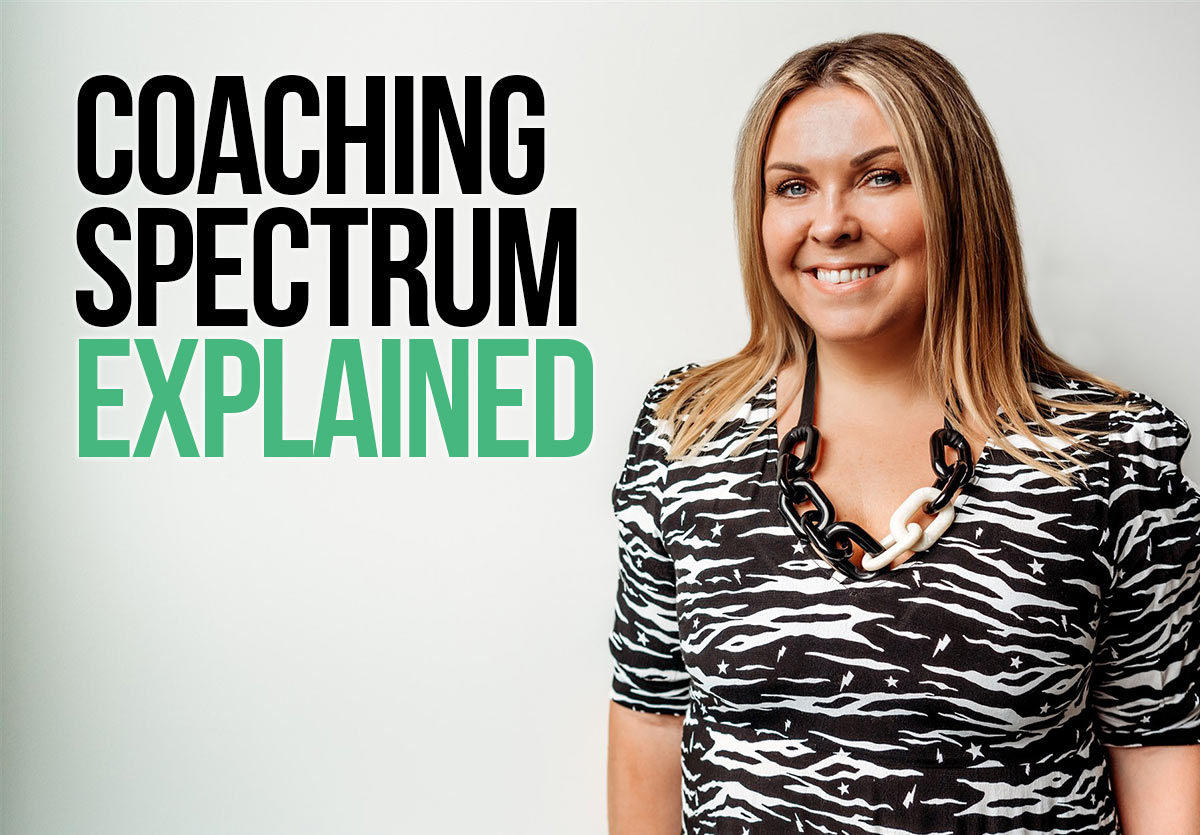If you’re new to coaching, you’ve probably heard the term “the coaching spectrum” mentioned in many blogs, articles and videos. But what is the coaching spectrum and how does it impact your coaching practice?
In this blog, we’ll explain what the coaching spectrum is. You’ll learn about the two coaching styles at either end of the spectrum, what they are and how to use them. As well as how they impact your practice and what effect each coaching style can have on your client’s outcomes.
What Is The Coaching Spectrum?
The coaching spectrum is a linear scale of coaching styles, with directive coaching at one end of the spectrum and non-directive at the other.
You can think of it like a paint colour spectrum that you’d see at a home decor store. Just as the paint colour spectrum starts with a light shade and gradually gets darker through the spectrum, ending in a darker shade.
The coaching spectrum is the same. It starts with a non-directive coaching style and as you go along the spectrum, it gradually mixes and transforms into a directive coaching style at the opposite end.

What Is Non-Directive Coaching?
Non-directive coaching is a coaching approach where you as the coach, take a passive but supportive role with your client.
A non-directive coaching style gives your client the chance to work out the answers to solve their own problems and make decisions using minimal guidance from you. Your role with this style of coaching is to facilitate rather than to ‘do’.
When you’re practising non-directive coaching, you’ll be using therapeutic strategies such as;
- Listening to understand your client
- Reflecting on their experiences
- Paraphrasing what they say
- Summarising what your client has described
- Asking questions that increase their awareness
When Is Non-Directive Coaching Helpful?
There’s a time and a place for everything. Although non-directive coaching has its limits, it has to be said that a little bit of non-directive coaching may be helpful at any time or place and for anyone.
This is because non-directive coaching is a non-judgemental and unbiased approach to support a person with their own ability to process events, understand situations and make decisions.
A non-directive coaching style puts you, the coach in the backseat. Allowing your client to have full control and take full responsibility for their own ideas, plans and decision-making.
If your client is on the right track but needs some encouragement or support to rethink things or see their situation from another perspective, non-directive coaching empowers them to work it out for themselves.
Self-directed, autonomous learning is an effective way to support personal growth, so non-directive coaching can be a really powerful tool, however, there are times when clients can get stuck – and that’s where directive coaching can be imperative.
What Is Directive Coaching?
Directive coaching is a coaching style where you as the coach take a direct role in the personal growth and development of your client and their outcomes. You engage in an active partnership with your client. The directive strategies that you use in your coaching will position you as the leader in the partnership and you will give advice and guidance from an assertive position.
Directive coaching strategies include;
- Making suggestions to your client
- Teaching strategies and techniques
- Giving feedback
- Offering guidance
- Giving advice
- Telling your client what they should do
A directive coaching approach assumes that you, the coach know all of the answers. You can think and act on behalf of your client and you can decide on the plan of action.
When Is Directive Coaching Helpful?
There are situations where directive coaching is particularly helpful to your client. These are times when your client needs to be challenged on something they believe or on an action they plan to take which could be damaging to them. Directive coaching allows you to take control and assert yourself as the authority so that your client will listen to your direction and take your advice that is in their best interests.
Directive coaching is also incredibly helpful when a client is stuck, struggling to see the next step they should take and answering a lot of non-directive questions with “I don’t know” or similar.
Which Approach Is Better?
The main benefit of a non-directive approach is that it allows for self-directed learning. This means that your job is to facilitate and create opportunities for your client to learn for themselves. When somebody learns through self-exploration and reflecting on their own past experiences, they’re more likely to implement the lessons that they’ve learned. As opposed to when somebody is told what to do. They might not fully understand the reason for the action and are more likely to make repeat mistakes.
Non-directive coaching puts the responsibility on the client to make the decisions. This means that the coach is not invested in the outcome, only in the process.
The main benefit of directive coaching is that the expert is the one in control and this can lead to better results in a shorter time. This approach can also prevent your client from encountering more difficulties because you have the foresight to be aware of the possibilities and can direct your client to avoid problems.
Neither approach is better than the other. The key is to understand your client and be responsive to what they need at different times throughout the coaching journey. You should be able to adjust your coaching style according to what will work best for your client.
The problem is that most coaching methods and training sit firmly at one end of the spectrum (usually at the non-directive end!) and don’t give coaches the skills they need to practice throughout the full spectrum of coaching. That’s why we created Paseda360…
How The Coaching Spectrum Impacts Your Coaching Practice
The coaching spectrum gives you a framework to work with that will help you to be responsive and adaptable to your client’s needs. Understanding the coaching spectrum and understanding your own talents and gifts as a coach, means that you can know when to amplify your natural tendencies towards one end of the spectrum and when you may need to bring in more of the opposite coaching style.
If you are able to use both ends of the coaching spectrum with your clients, you will be able to develop a relationship of great trust and understanding that will develop into amazing results.
Most coaching training sits firmly at the non-directive end of the spectrum, with a few methods sitting at the directive end. Paseda360 is the ONLY coaching method that equips you with the skills, knowledge and tools to be able to work throughout the whole spectrum, adapting your coaching to meet your client’s unique needs. Working on both a conscious and unconscious level, this 360-degree method can have an incredible impact on all areas of life. You can learn more about Paseda360 here…
If you want to read more about the non-directive approach of the coaching spectrum, read our blog The Problem With Non-Directive Coaching here…







